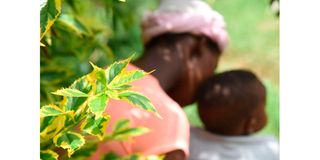Defiled, pregnant and HIV positive, the triple threat to Kenya’s teen girls.

A teenage girl with her child. Last year, when schools were closed in March to contain the spread of Covid-19, more than 1,400 teenagers became pregnant.
Teenage girls in Kenya face the triple threats of violation, pregnancy and being infected with HIV, new data shows, and the number of 10- to 19-year-olds falling pregnant in Kenya is still alarmingly high, with the numbers rising.
Out of 10 girls aged 10 to 19 in Bomet County, four of them fell pregnant in 2021. The county was also leading in teenage pregnancy, going by data from the National Council for Population and Development (NCPD).
The data released yesterday reveals that 17 counties have this year recorded an increase in adolescent pregnancy.
Mandera came second with 32 percent, followed by Kisii County (29 percent), Nyandarua (28 percent), Baringo (26 percent), Kakamega (25 percent), Kitui (23 percent), Migori (21 percent) and Kirinyaga (19 per cent).
A monthly trend analysis on the teenagers at antenatal clinics indicates a 15 percentage increase in the numbers for adolescents aged 10 to 14, and 15 to 19.
In Kenya’s history, 2018 recorded the highest number of teenage pregnancies at 427,135. By September this year, 23,117 girls between the ages 10 and 19 were pregnant.
In the last five years, the figures have remained unchanged and it looks like there is nothing happening in the country to reduce the numbers.
Clinic visits
The figures are derived from clinic visits, meaning the number could be higher, given that some teenagers do not attend clinic when they are expectant.
This is even as the same age group recorded 5,492 HIV new infections and 1,473 HIV-related deaths between January and October 2021, from HIV, the data shows.
Nationally, Kenya has reduced new HIV infections by 10,000. Last year, there were 42,000 new infections, while this year, the country has recorded close to 32,000 new infections.
“We missed our target on HIV prevention. Although we have done well, we wanted to be at 25,000 or less. We slightly missed it,” said National Aids Control Council CEO Ruth Masha.
According to Dr Masha, it will be impossible to end HIV in Kenya if young people are left behind. She urged Kenyans to stop condemning people giving HIV and sex education to young people.
“The reality is that these children are having sex. We need to give them comprehensive information. We must start having different conversations on how then do we pack the information and ensure we are ending pregnancy and HIV among adolescents,” she said.
The reason HIV gains in Kenya are very fragile is that education on the virus does not concentrate on the young ones, she added.
Going by the actual numbers, five counties led with high cases of pregnancy among teenagers in 2021, including Nairobi (2,379), Homa Bay (1,530), Kajiado (1,496), Mandera (1,370) and Bomet (1,041).
Nine counties -- Nairobi, Kajiado, Homa Bay, Meru, Kericho, Narok, Kisii, Mandera and Bomet contributed to 56 per cent (20,803) of the total teenage pregnancies among adolescents aged 10 and 14 years.
The five most improved counties were Kericho at 28 per cent from 34 per cent per cent last year, Trans Nzoia at 27 per cent from 41 per cent, Vihiga at 27 per cent from 40 per cent, Kericho at 27 per cent from 34 per cent, and Nandi at 25 per cent from 34 per cent.
Teenagers below 19 years have contributed to 45 per cent of maternal mortality in the country. According to Dr Masha, teenage pregnancy is a big challenge in Kenya.
“Some of them are pregnant and at the same time, they are HIV positive, so they start taking drugs for life. The counseling is traumatising, girls in Kenya are actually experiencing triple threats of teenage pregnancy, HIV infection and violation,” she said.
Maternal mortality
Dr Mohamed Sheikh, the director general of NCPD, said: “Our slogan has always been ‘no motherhood in childhood’. When you look at the ratio of maternal mortality, it is twice as high in teenage girls compared to women of reproductive age. Complications is one of the factors leading to the deaths because they are not well developed to give birth.”
Kenya is among the countries with the highest burden of teenage pregnancy and motherhood, and one in every teenage girl in Kenya aged between 10 and 19 is either pregnant or has given birth to her first child. The prevalence has not changed since 2008.
This is the same age group that has recorded high unmet needs of contraception, at 23 percent against 18 percent of the national figures, with more than 60 percent not using any method.
These figures are very high, we need to find out whether it is an issue of access or knowledge, we need to find out and work towards reducing the numbers,” Dr Sheikh said.
“We need to address teenage pregnancies based on the drivers because each county has a unique driver of the vice, we need to contextualise the issue since it's key to achieving development agendas,” he said.
“The data is scary and we must come together in a movement and end teenage pregnancy,” Dr Masha said.





